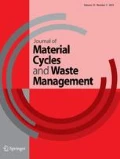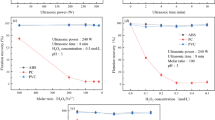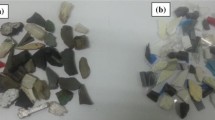Abstract
Acrylonitrile butadiene styrene (ABS), as a main component of plastics of waste electrical and electronic equipment (WEEE), shows high potential for recycling, which is restricted by the absence of an efficient separation method. Herein, a novel surface treatment method, microwave treatment combined with a wetting agent, was proposed to selectively change the hydrophilicity of the mixed waste plastics, which efficiently separated ABS from the WEEE plastics by flotation. The results of this approach provided the following optimal conditions, i.e., microwave power 700 W, microwave irradiation time 3 min, concentration of wetting agent carboxymethylcellulose sodium (CMC) 25 mg/L, treatment time with CMC 5 min, stirring rate 1800 rpm, frother concentration 40 mg/L, and flotation time 4 min. Under these optimal conditions, the recovery and the purity of ABS reached 97.70% and 99.86%, respectively. The mechanism of the surface treatment was examined by means of contact angle, Fourier transform infrared spectroscopy (FT-IR), and adsorption kinetics. The results showed that the selective wetting mechanism can be attributed to the physisorption of CMC on the surface of plastics. In conclusion, this surface treatment method is expected to provide technological insights for the separation and recovery of waste ABS from WEEE plastics.







Similar content being viewed by others
References
Yang X, Sun L, Xiang J, Hu S, Su S (2013) Pyrolysis and dehalogenation of plastics from waste electrical and electronic equipment (WEEE): a review. Waste Manag 33:462–473. https://doi.org/10.1016/j.wasman.2012.07.025
Zeng X, Gong R, Chen W, Li J (2016) Uncovering the recycling potential of “new” WEEE in China. Environ Sci Technol 50:1347–1358. https://doi.org/10.1021/acs.est.5b05446
Truc NTT, Lee B-K (2016) Sustainable and selective separation of PVC and ABS from a WEEE plastic mixture using microwave and/or mild-heat treatment with froth flotation. Environ Sci Technol 50:10580–10587. https://doi.org/10.1021/acs.est.6b02280
Wang J, Wang H, Yue D (2019) Optimization of surface treatment using sodium hypochlorite facilitates coseparation of ABS and PC from WEEE plastics by flotation. Environ Sci Technol 53:2086–2094. https://doi.org/10.1021/acs.est.8b06432
Martinho G, Pires A, Saraiva L, Ribeiro R (2012) Composition of plastics from waste electrical and electronic equipment (WEEE) by direct sampling. Waste Manag 32:1213–1217. https://doi.org/10.1016/j.wasman.2012.02.010
Wang H, Zhang Y, Wang C (2019) Surface modification and selective flotation of waste plastics for effective recycling——a review. Sep Purif Technol 226:75–94. https://doi.org/10.1016/j.seppur.2019.05.052
Zhou C, Fang W, Xu W, Cao A, Wang R (2014) Characteristics and the recovery potential of plastic wastes obtained from landfill mining. J Clean Prod 80:80–86. https://doi.org/10.1016/j.jclepro.2014.05.083
Thanh Truc NT, Le HA, Nguyen DT, Pham T-D (2019) Novel method for sustainable and selective separation of PVC and PET by the homogeneous dissociation of H2O2 using ultrasonication. J Mater Cycles Waste Manag 21:1085–1094. https://doi.org/10.1007/s10163-019-00861-1
Wang J, Wang H, Yue D (2019) Separation of waste polymethyl methacrylate and polyvinyl chloride mixtures by flotation after Fenton oxidation. J Clean Prod 228:1218–1228. https://doi.org/10.1016/j.jclepro.2019.04.349
Zhao Y, Mishra P, Han F, Liu X, Shen Z (2019) Surface micro-alcoholysis treatment: a novel approach towards froth flotation based separation for binary mixtures of polyethylene terephthalate and polyvinyl chloride. J Clean Prod 232:848–857. https://doi.org/10.1016/j.jclepro.2019.06.031
Reddy MS, Okuda T, Kurose K, Tsai T-Y, Nakai S, Nishijima W, Okada M (2010) Surface ozonation of polyvinyl chloride for its separation from waste plastic mixture by froth floatation. J Mater Cycles Waste Manag 12:326–331. https://doi.org/10.1007/s10163-010-0305-x
Ito M, Takeuchi M, Saito A, Murase N, Phengsaart T, Tabelin CB, Hiroyoshi N, Tsunekawa M (2019) Improvement of hybrid jig separation efficiency using wetting agents for the recycling of mixed-plastic wastes. J Mater Cycles Waste Manag 21:1376–1383. https://doi.org/10.1007/s10163-019-00890-w
Negari MS, Ostad Movahed S, Ahmadpour A (2018) Separation of polyvinylchloride (PVC), polystyrene (PS) and polyethylene terephthalate (PET) granules using various chemical agents by flotation technique. Sep Purif Technol 194:368–376. https://doi.org/10.1016/j.seppur.2017.11.062
Zhao Y, Li Y, Huang J, Liu J, Wang W (2015) Rebound and attachment involving single bubble and particle in the separation of plastics by froth flotation. Sep Purif Technol 144:123–132. https://doi.org/10.1016/j.seppur.2015.02.016
Zhang Y, Jiang H, Wang K, Wang H, Wang C (2020) Green flotation of polyethylene terephthalate and polyvinyl chloride assisted by surface modification of selective CaCO3 coating. J Clean Prod 242:118441. https://doi.org/10.1016/j.jclepro.2019.118441
Wang J, Wang H, Wang C, Zhang L, Wang T, Zheng L (2017) A novel process for separation of hazardous poly(vinyl chloride) from mixed plastic wastes by froth flotation. Waste Manag 69:59–65. https://doi.org/10.1016/j.wasman.2017.07.049
Wang H, Wang C, Fu J, Gu G (2014) Flotability and flotation separation of polymer materials modulated by wetting agents. Waste Manag 34:309–315. https://doi.org/10.1016/j.wasman.2013.11.007
Remya N, Lin J-G (2011) Current status of microwave application in wastewater treatment—A review. Chem Eng J 166:797–813. https://doi.org/10.1016/j.cej.2010.11.100
Truc NTT, Lee B-K (2017) Combining ZnO/microwave treatment for changing wettability of WEEE styrene plastics (ABS and HIPS) and their selective separation by froth flotation. Appl Surf Sci 420:746–752. https://doi.org/10.1016/j.apsusc.2017.04.075
Zhao Y, Han F, Abdelaziz IIM, Liu X, Ghazali KH, Mishra P (2019) Application of biosurfactant tea saponin in flotation separation for ternary plastic mixtures: statistical optimization and mechanism analysis. J Clean Prod 232:499–507. https://doi.org/10.1016/j.jclepro.2019.06.002
Wang C, Wang H, Wu B, Liu Q (2014) Boiling treatment of ABS and PS plastics for flotation separation. Waste Manag 34:1206–1210. https://doi.org/10.1016/j.wasman.2014.02.005
Zhao Y, Yang S, Wen H, Shen Z, Han F (2019) Adsorption behavior and selectivity mechanism of flotation reagents applied in ternary plastic mixtures. Waste Manag 87:565–576. https://doi.org/10.1016/j.wasman.2019.02.044
Wang C, Wang H, Huang L (2017) A novel process for separation of polycarbonate, polyvinyl chloride and polymethyl methacrylate waste plastics by froth flotation. Waste Manag 65:3–10. https://doi.org/10.1016/j.wasman.2017.04.006
Wang H, Wang J, Zou Q, Liu W, Wang C, Huang W (2018) Surface treatment using potassium ferrate for separation of polycarbonate and polystyrene waste plastics by froth flotation. Appl Surf Sci 448:219–229. https://doi.org/10.1016/j.apsusc.2018.04.091
T.N Z (1958) Suspending solid particles in liquid by agitators. Chem Engineer 8:244–253
Yu Y, Cheng G, Ma L, Huang G, Wu L, Xu H (2017) Effect of agitation on the interaction of coal and kaolinite in flotation. Powder Technol 313:122–128. https://doi.org/10.1016/j.powtec.2017.03.002
Yang L, Zhao Y, Yang J, Li Y, Meng Q (2014) Visualized study on the interaction between single bubbles and curved solid surface in flotation separation process. Water Sci Technol 70:627–633. https://doi.org/10.2166/wst.2014.266
Wang J, Wang H, Huang L, Wang C (2017) Surface treatment with Fenton for separation of acrylonitrile-butadiene-styrene and polyvinylchloride waste plastics by flotation. Waste Manag 67:20–26. https://doi.org/10.1016/j.wasman.2017.05.009
Wang J, Wang H (2017) Fenton treatment for flotation separation of polyvinyl chloride from plastic mixtures. Sep Purif Technol 187:415–425. https://doi.org/10.1016/j.seppur.2017.06.076
Zhang Y, Chen S, Wang H, Luo M (2019) Separation of polyvinylchloride and acrylonitrile-butadiene-styrene combining advanced oxidation by S2O82-/Fe2+ system and flotation. Waste Manag 91:80–88. https://doi.org/10.1016/j.wasman.2019.04.048
Wang X, Wang X, Chen Z (2007) Study on reconstruction mechanism at the surface of a glassy polymer. Polymer 48:522–529. https://doi.org/10.1016/j.polymer.2006.11.043
Chen Y, Zhang D (2014) Adsorption kinetics, isotherm and thermodynamics studies of flavones from Vaccinium Bracteatum Thunb leaves on NKA-2 resin. Chem Eng J 254:579–585. https://doi.org/10.1016/j.cej.2014.05.120
Demirbas E, Dizge N, Sulak MT, Kobya M (2009) Adsorption kinetics and equilibrium of copper from aqueous solutions using hazelnut shell activated carbon. Chem Eng J 148:480–487. https://doi.org/10.1016/j.cej.2008.09.027
Rahmanian O, Dinari M, Abdolmaleki MK (2018) Carbon quantum dots/layered double hydroxide hybrid for fast and efficient decontamination of Cd(II): the adsorption kinetics and isotherms. Appl Surf Sci 428:272–279. https://doi.org/10.1016/j.apsusc.2017.09.152
Acknowledgements
The authors would like to thank the Natural Science Foundation of Shaanxi Province (2020JM-236) and the Fund Project of Shaanxi Key Laboratory of Land Consolidation (2018-ZD04) for funding this project.
Author information
Authors and Affiliations
Corresponding author
Additional information
Publisher's Note
Springer Nature remains neutral with regard to jurisdictional claims in published maps and institutional affiliations.
Electronic supplementary material
Below is the link to the electronic supplementary material.
Rights and permissions
About this article
Cite this article
Qu, Y.h., Li, Y.p., Zou, X.t. et al. Microwave treatment combined with wetting agent for an efficient flotation separation of acrylonitrile butadiene styrene (ABS) from plastic mixtures. J Mater Cycles Waste Manag 23, 96–106 (2021). https://doi.org/10.1007/s10163-020-01099-y
Received:
Accepted:
Published:
Issue Date:
DOI: https://doi.org/10.1007/s10163-020-01099-y




